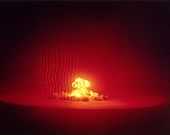Upshot-Knothole Annie
| Upshot-Knothole Annie | |
|---|---|
 | |
| Information | |
| Country | United States |
| Test series | Operation Upshot-Knothole |
| Test site | Nevada Test Site |
| Date | March 17, 1953 |
| Test type | Atmospheric |
| Yield | 16 kt |
Upshot-Knothole Annie was a nuclear weapons test conducted by the United States as part of Operation Upshot-Knothole. It took place at the Nevada Test Site on 17 March 1953, and was nationally televised.[1] The live TV coverage was captured at the studio, presumably using at-the-time new magnetic tape sound technology, so it is a rare record of the sound an actual atomic bomb makes.[2]
Operation Doorstep was a civil defense study conducted by the Federal Civil Defense Administration in conjunction with Annie. It studied the effect of the nuclear blast on two wooden frame houses, fifty automobiles and eight bomb shelters designed for residential use.
The administration concluded that if windows were left open to prevent the car collapsing on its occupants a car would be "relatively safe" from a small nuclear bomb if at least ten blocks away from the hypocenter. The homes in the study were constructed in such a way as to minimize the thermal effects of Annie, with an eye towards determining if, in the absence of fire, the basement of the closer home — 3,500 feet (1,100 m) from the hypocenter — might shelter its occupants, while the second — at 7,500 feet (2,300 m) — could remain standing.[3] Both homes performed as expected under the conditions of their construction.
References
| Wikimedia Commons has media related to Upshot-Knothole Annie. |
- ↑ Eden, Lynn (2004). Whole world on fire: organizations, knowledge, and nuclear weapons devastation. Cornell University Press. p. 166. ISBN 978-0-8014-3578-2. Retrieved 29 March 2011.
- ↑ Operation Upshot-Knothole Shot Annie, Youtube.com, retrieved October 27, 2013
- ↑ Eden (2004), pp. 166-167.
Coordinates: 37°02′52″N 116°01′19″W / 37.0477°N 116.022°W